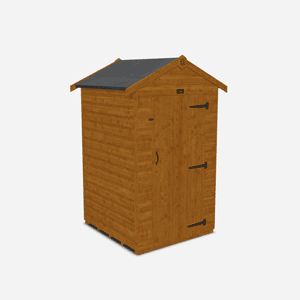Shed Storage: How to Organise a Shed
Published: 28/05/2021

How to Maximise Shed Storage
So, you've got yourself a shed, huh? Nice move! But let's face it, it's not just a place to toss your old lawnmower and rusty tools. Nope, it's a storage goldmine waiting to be maximised! Whether you're into gardening, DIY projects, or just need a spot for all those random bits and bobs, your shed can be a total game-changer. So, grab a cuppa, because we’re about to spill the beans on how to turn that little ol' shed of yours into the storage palace of your dreams! Let's dive in!
Clean out your Shed
Alrighty, folks, it's time to tackle that shed clutter! But fear not, because we're about to turn this chaos into organised bliss! First things first, grab some tunes – a shed-clearing playlist is a must to keep those motivation levels up. Next, arm yourself with bin bags, a broom, and maybe even a sturdy pair of gloves. Now, let's get ruthless! Start by sorting items into three piles: keep, donate, and bin. Once you've whittled down the clutter, it's time to get strategic with storage. Shelves, hooks, and labelled storage containers are your new best friends.
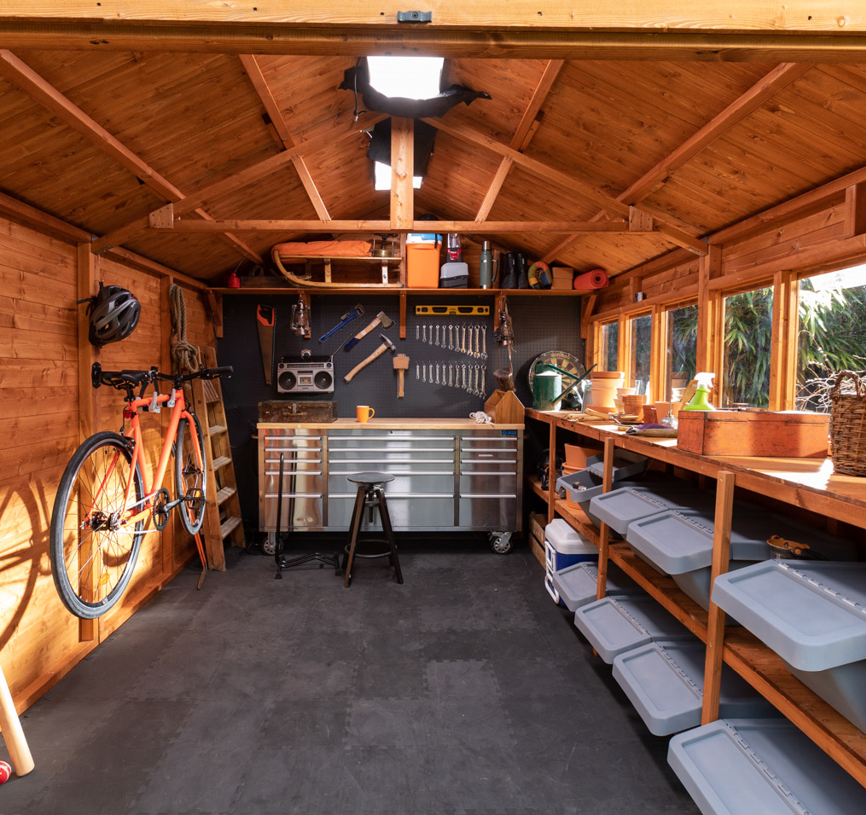
https://www.tigersheds.com/product/tiger-heavyweight-workshop-shed/
Dispose of Junk
Chuck out the clutter without a second thought! Now, for the stuff that still has a little value… you can pop those goodies on your go-to auction or buy and sell site, for a little bit of extra cash. Who knows, one man's trash could be another's treasure, right?
Group Similar Items
Now that we've narrowed down the survivors, how you organise them is your call – maybe you're all about grouping by product type, or perhaps you prefer sorting by purpose or size. It's your shed kingdom, so make it work for you.
Label Items
Grab some colourful markers, sticky notes, or even a label maker if you're feeling fancy. Now, get creative with those storage labels! You can go simple with just names or get specific with categories like "Garden Goodies" or "Power Tools Paradise." And hey, don't forget to stick 'em where they're easy to see!
Upcycling
Think about those old shelves gathering dust in your garage or maybe even hiding in a forgotten corner of your house. Kitchen shelves, bedroom units – you name it, they can find a new home in your shed! Whether they're meant to hang on the wall or stand freely, you can give these a new lease on life. And hey, don't overlook those tired-looking cabinets either – they might've lost their charm indoors, but they'll fit right in outside in your shed! Oh, and get this – you could even whip up a funky cupboard using old doors. Get crafty with what you’ve got!
Start Planning Shed Storage Ideas
Grab a notepad and a trusty pen – it's brainstorming time. Think about what you need to store and how often you'll be reaching for those items. Maybe it's gardening gear, power tools, or for your garden furniture. Once you've got a rough idea, sketch out your space – where will the shelves go? Any hooks or racks? Don't forget to leave room to move around and access your stuff! This is your chance to customise your storage haven exactly how you want it.
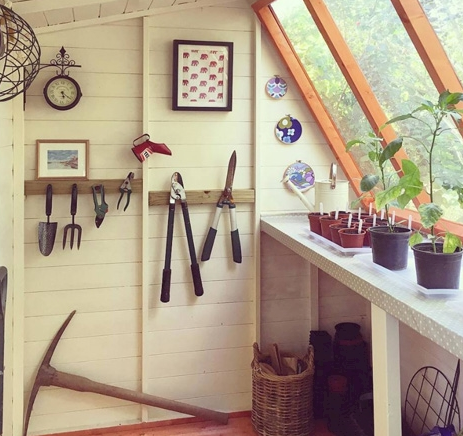
Shed Storage Ideas
Let's chat shed storage solutions! Transform your shed into a clutter-free oasis with clever solutions for every item. Hang tools on hooks, stack pots on shelves, and corral small items in bins. Add a pegboard or magnetic strip for easy access to essentials. With a touch of creativity, your shed can become a tidy storage haven, keeping your outdoor space organised.
Shelving
Let’s talk about shed shelving – the unsung hero of shed organisation! With some cleverly placed shelves, suddenly you've got storage space galore. You can even add hooks for hanging tools and add storage bins on the shelves for corralling smaller items – the possibilities are endless! It's like giving your shed a mini makeover, maximising every inch of space and turning chaos into order. So, if you're tired of tripping over clutter every time you step into your shed, it's time to embrace the magic of shelving.
Pegboards
Pegboard storage - the secret weapon for shed organization! Imagine walking into your shed and seeing everything neatly hanging in its place, like a mini hardware store display. That's the power of a pegboard! With a few hooks and pegs, suddenly your shed walls become useful! Whether you're a DIY enthusiast or just looking to tame the clutter, pegboard storage is a game-changer for sheds.
Using Doors & Outside Walls
In need of small, shed storage ideas? Using doors and outside walls for shed storage is like unlocking a whole new level of organisation! Picture this: you swing open the door to your shed, and instead of just staring at a blank wall, you see hooks, racks, and shelves cleverly attached to make the most of every inch of space. Hang up your shovels, rakes, and brooms on hooks, install a few shelves for pots, gardening supplies, or even a toolbox – suddenly, you've got storage where you least expected it. And the best part? By utilising the doors and outside walls of your shed, you're freeing up valuable floor space inside, making it feel bigger and more organised. So, if you're tired of tripping over clutter, it's time to put those doors and walls to work.
Magnetic Tool Holders
It’s like magic for your shed! Imagine walking into your shed and seeing your tools neatly stuck to the walls, like they're defying gravity. That's the power of magnets! With magnetic tool storage, you can say goodbye to rummaging through drawers or hunting for misplaced items. Just stick your wrenches, screwdrivers, and even small metal parts right onto the magnetic strip or board, and voila! Plus, since it doesn't take up any floor space, it's perfect for small sheds where every inch counts. So, if you're tired of the clutter and chaos in your shed, it's time to let magnets work their magic.
Drawer Organisers
Shed drawer organisers are fantastic because instead of opening up your drawer and finding a mess of nails, tools and random bits, you will find everything neatly sorted into separate compartments, like a little DIY treasure trove. That's the magic of drawer organisers! Whether it's small tools, hardware, or gardening accessories, these nifty organisers keep everything in its place, making it a breeze to find what you need when you need it. They're super versatile and come in all shapes and sizes, so you can customize them to fit any drawer or shelf in your shed.
Overhead Storage
Overhead shed storage…it's like discovering a whole new dimension of space! With a few sturdy shelves or racks installed near the shed roof, suddenly you've got the perfect spot to stash away those bulky items like camping gear and seasonal decorations. It's like creating your own little attic in the sky! And the beauty of it is, you're not sacrificing any precious floor space. Plus, with everything off the ground, you'll have a clear path to walk and work without tripping over clutter.
Potting Bench
A shed potting bench is like a gardener's dream come true! But wait, it's not just for potting plants! Usually with tiered shelves, you can add additional hooks and storage containers, ensuring you’re your potting bench doubles as the ultimate storage solution for all your gardening gear.

Product – Tiger Potting Shed
What NOT To Store in a Shed
A garden shed can quickly turn into a cluttered mess if we're not careful! But fear not, because I've got the lowdown on what NOT to stash in your shed. From paint cans to canned goods, and even your favourite wine stash, we're about to dish out some friendly advice on how to keep your shed from turning into a storage disaster zone. So, let’s chat about what belongs – and what doesn’t belong – in your little outdoor oasis!
1. Paint, Glue, or Hazardous Materials: You don’t want to keep your paint cans or glue bottles in the shed! Those chemicals can get all wonky with the temperature changes out there. Plus, if they leak or spill, it could turn into a seriously messy situation. Best keep those bad boys in a well-ventilated spot, away from the shed.
2. Paper Goods such as Plates: Plates and napkins might seem like a good idea for shed storage, but they won't stay pristine for long out there. Moisture, bugs, and mould love to party with paper goods, and nobody wants that kind of surprise at their picnic. Keep your plates indoors where they belong!
3. Canned Food: Think twice before stocking your shed pantry with canned goodies. Those temperature swings can do harm to canned food, making it spoil way faster than it should. Plus, bugs and critters might think it's an all-you-can-eat buffet. Keep your canned goods safe and sound in the kitchen cupboard.
4. Photographs and Paperwork: Moisture and pests can wreak havoc on photos and paperwork, turning cherished memories into mush. Keep them safe and dry indoors.
5. Household Appliances and Electronics: Your shed might seem like a handy spot to stash that old toaster or extra TV, but it’s not the best idea. Moisture and pests can turn those gadgets into useless junk faster than you can say "fix it, please!" Keep your electronics cosy inside the house where they'll stay in tip-top shape.
6. Clothing and Bedding: Who wants to cosy up with mouldy blankets or moth-eaten sweaters? No thanks! Storing clothes and bedding in the shed might seem like a space-saving move, but it's a gamble. Keep those threads safe and dry inside where they belong!
7. Wine: Don't let your precious wine collection turn into vinegar! Storing wine in the shed might sound sophisticated, but it's a disaster waiting to happen. Fluctuating temperatures and sunlight can turn your vino into a sad, sour mess. Keep it in the cellar or pantry where it can age gracefully.
8. Musical Instruments: Your guitar might love jam sessions, but it definitely won't appreciate the wild temperature swings of the shed. Instruments are delicate creatures, and they need a stable environment to stay in tune.
What are the best Outdoor Storage Sheds?
If you're on the hunt for the perfect outdoor storage shed to declutter your garden, you've come to the right place! Today, we're diving into the wonderful world of shed shopping and breaking down the top contenders: wooden sheds, metal sheds, and plastic sheds. Each has its own perks and quirks, so let's take a closer look and see which one might be your new storage best friend!
Wooden Sheds
Pros
Aesthetics: Wooden sheds have a classic, rustic look that many people find appealing, blending well with outdoor environments.
Customisation: Wood is easy to work with, allowing for customisation and personalisation of shed design and features.
Insulation: Wooden sheds provide better insulation compared to metal or plastic sheds, making them suitable for storing temperature-sensitive items.
Cons
Maintenance: Wooden sheds require regular maintenance, including painting or staining to protect against weathering, rot, and insect damage.
Cost: Wooden sheds tend to be more expensive upfront compared to metal or plastic sheds due to the cost of materials and construction.
Durability: While well-maintained wooden sheds can be durable, they may be more susceptible to damage from moisture, pests, and decay over time.
Best for: Those who prioritise aesthetics and want a customisable storage solution that blends seamlessly with their outdoor space. Wooden sheds are ideal for storing gardening tools, outdoor equipment, and other items that may benefit from insulation.
Metal Sheds
Pros
Durability: Metal sheds are highly durable and resistant to rot, pests, and decay, making them low-maintenance and long-lasting.
Security: Metal sheds provide excellent security for stored items, as they are often equipped with locking mechanisms and sturdy construction.
Affordability: Metal sheds are generally more affordable than wooden sheds, offering a cost-effective storage solution.
Cons
Limited Aesthetics: Metal sheds may lack the charm and visual appeal of wooden sheds, as they have a more utilitarian appearance.
Susceptible to Dents and Corrosion: While durable, metal sheds can be prone to dents from impacts and corrosion over time, especially in areas with high humidity or salt exposure.
Temperature Control: Metal sheds may experience temperature extremes, becoming hot in summer and cold in winter, which can affect stored items.
Best for: Those seeking a low-maintenance, secure, and cost-effective storage solution. Metal sheds are suitable for storing tools, equipment, and items that don't require insulation or temperature control.
Plastic Sheds
Pros
Low Maintenance: Plastic sheds require minimal maintenance, as they are resistant to rot, rust, and decay, and do not require painting or staining.
Easy Assembly: Plastic sheds are typically lightweight and easy to assemble, requiring minimal tools and time.
Affordability: Plastic sheds are often the most affordable option, making them budget-friendly for homeowners.
Cons
Limited Durability: While resistant to rot and rust, plastic sheds may be less durable than wooden or metal sheds, especially in harsh weather conditions as they can fade and warp.
Limited Customisation: Plastic sheds have limited customisation options compared to wooden sheds, as they are pre-fabricated and may not be easily modified.
Aesthetics: Plastic sheds may not have the same aesthetic appeal as wooden sheds, as they have a more utilitarian appearance.
Best for: Those seeking a low-maintenance and budget-friendly storage solution. Plastic sheds are suitable for storing lightweight items, gardening tools, and outdoor equipment in moderate climates.
In summary, timber garden sheds reign supreme as the ultimate storage solution for a multitude of reasons. Firstly, their timeless aesthetic adds a touch of natural charm to any backyard, seamlessly blending with the surrounding environment. Beyond their beauty, timber sheds offer unparalleled durability and insulation, keeping your belongings safe from the elements year-round. Additionally, timber's versatility allows for easy customisation, ensuring your shed perfectly suits your storage needs. From gardening tools to outdoor equipment, timber garden sheds provide ample space while maintaining a cosy, inviting atmosphere. So, if you're seeking a storage solution that combines functionality with timeless elegance, look no further than a timber garden shed.
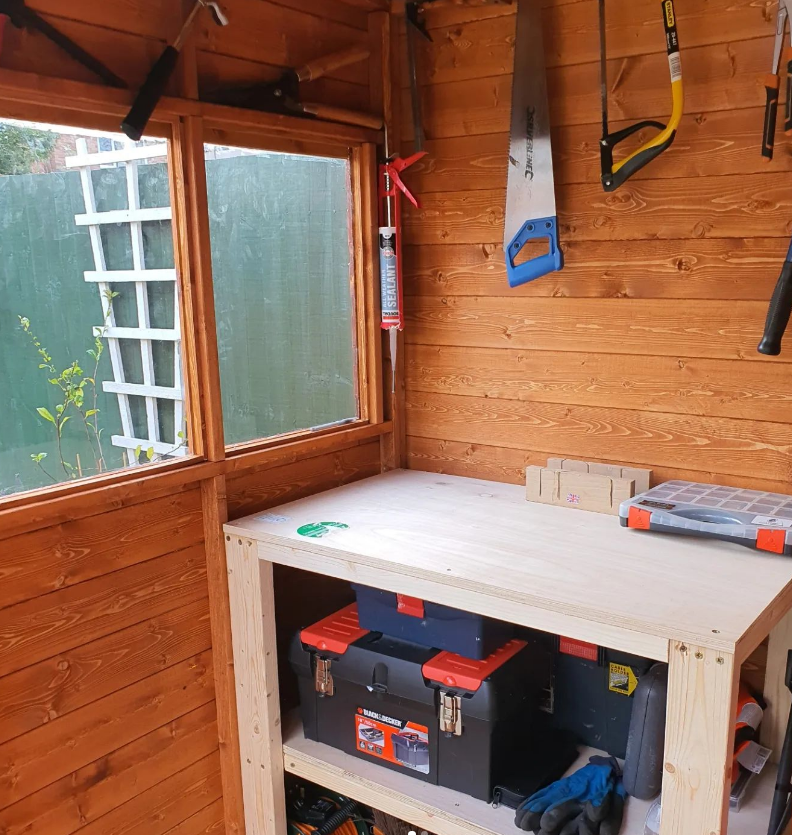
Product – Tiger Deluxe Corner Shed
Our Storage Solutions
If you're on the lookout for top-notch outdoor storage solutions, you're in luck – because we've got just the thing to declutter your space and keep your belongings safe and sound. Introducing our lineup of Tiger Shed outdoor storage products! From bike enthusiasts to firewood fanatics and DIY darlings, there's something here for everyone. So, let's dive in and explore how these trusty companions can help you conquer clutter and reclaim your outdoor oasis!
Bike Storage
Our bike storage units are like a cosy garage for your two-wheeled treasures, keeping them safe, secure, and out of the elements. Say goodbye to rusty chains and tangled spokes – with easy access and sturdy construction, these bike sheds are a cyclist's dream come true. Whether you're a weekend warrior or a daily commuter, our bike storage solutions are here to keep your wheels rolling smoothly and your outdoor space clutter-free!
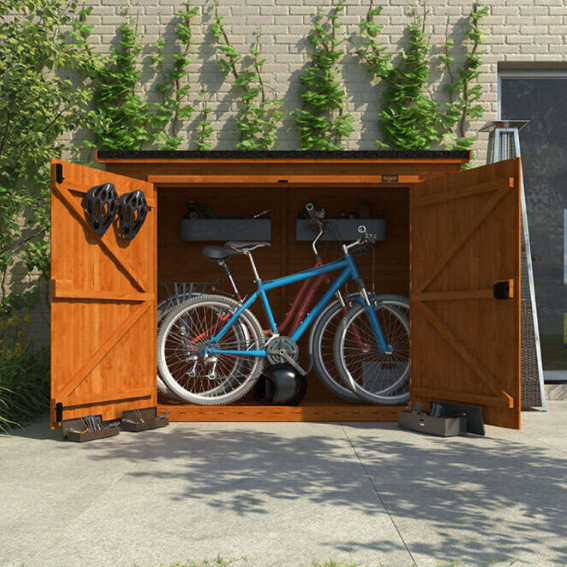
Product – Tiger Pent Bike Store
Log Storage
It’s time to get your log storage game on point! Our log storage solutions are like a log cabin for your firewood, keeping it dry, organised, and ready to fuel your outdoor adventures. No more soggy logs or scavenging for kindling – with ample space and breathable construction, these storage units ensure your firewood stays seasoned, organised and ready to ignite at a moment's notice.

Product – Tiger Pressure Treated Log Store
Tool Storage
Our timber tool storage units are like a small workshop, keeping your hammers, saws and screwdrivers organised, accessible, and always at your fingertips. Say goodbye to digging through cluttered toolboxes or hunting for misplaced wrenches – with customisable storage options and sturdy construction, these units are a handyman's best friend.
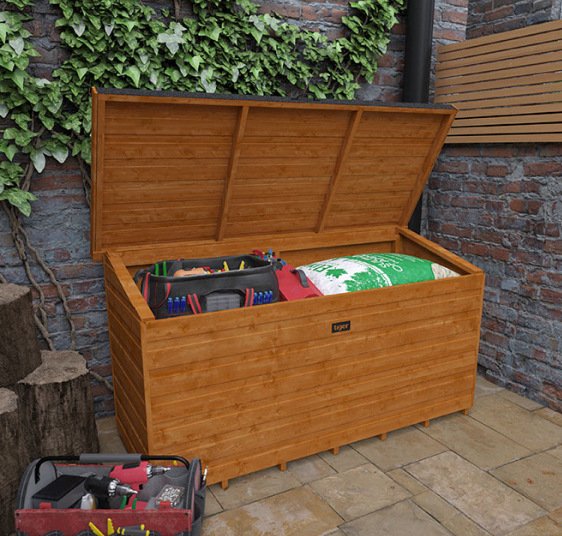
Product – Tiger Wooden Tool Chest
Bin Storage
It’s time to tidy up that recycling station in your backyard! Our bin storage solutions are designed to keep your bins neatly tucked away, organised, and ready for action. Say goodbye to unsightly bins cluttering up your outdoor space or tipping over in the wind – with discrete storage options and sturdy construction, these units make storing household waste a breeze.

Product – Tiger Bin Store – Triple
If you’re still looking for more inspiration you can find your perfect garden storage space over in this article.


